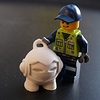If I may offer my experience with acetone vapor smoothing for ABS.
I find that using only vapor, the detail of the print is damaged too much by the time the required smooth finish is achieved. To overcome this, I do my treatment as a 2 part process :
I use step 1 to strengthen the part ( using the acetone to better join the layers ), and then step 2 to make it look good and glossy.
Note : I do not sand any part until after step 1. I think that if you sand the part, you are clogging the small gaps between layers with dust and limiting how well the acetone can work.
so step 1 : to strengthen the part, I either dip the entire part in acetone, or if it is larger I use a 1cm wide paintbrush and paint on the acetone. After each I shake / blow off the excess acetone.
After step 1, the part will have a white / light patchy stain over most parts, and you’ll think you have ruined your print - do not worry - you have not.
Leave it for 1 hour for the acetone to evaporate and the ABS to harden. You can then do any sanding that you want.
Step 2 is to give the part the gloss shine - do a hot acetone vapor treatment and you’ll see the discoloration disappear within a few seconds. Vapor treatment only takes about 5 to 10 seconds.
My hot acetone vapor treatment takes me about 4 minutes in total from start to glossy print.
I use an old cheap tin cooking pot, about 2-3 liter capacity. A large deep metal coffee tin would work just as well.
I rinse the pot with a little water, pour out the water, and then heat the pot on an outdoors gas cooker ( bbq ).
Heat until the last of the water has boiled away. This means that the pot is now hot.
Use a small jar to measure about 30ml acetone - keep it covered and away from the gas flame.
Turn off the gas - this is an important step !!
Now pour the acetone in to the pot and put on the lid.
Wait about 20 - 30 seconds for the acetone to vaporize.
Slide off the lid and insert your print ( hanging from a wire or cotton thread ).
You can watch the color return and the gloss appear in a few seconds.
Remove the part and hang to dry for 15 minutes.
Done.
 may I ask what ABS and/or PLA you use in your mini ? Always the UP filament or another that works well ? And where do you order from ?
may I ask what ABS and/or PLA you use in your mini ? Always the UP filament or another that works well ? And where do you order from ? I will now try the same with the non OEM silver and temp mod down to 230c and see if the outcome is as good
I will now try the same with the non OEM silver and temp mod down to 230c and see if the outcome is as good